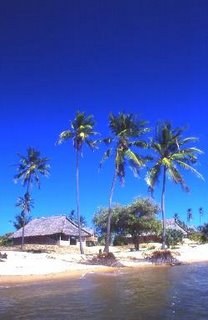Lamu
 Lamu is a small archipelago off the north coast of Kenya. It was once a significant trading place from Africa to the East, but is now better known for its slow pace of life, beautiful beaches and overwhelming sense of history.
Lamu is a small archipelago off the north coast of Kenya. It was once a significant trading place from Africa to the East, but is now better known for its slow pace of life, beautiful beaches and overwhelming sense of history.Lamu Archipelago is made up of several islands, the largest of which are Lamu Island, Manda Island and Pate Island. Smaller islands include Kiwayu, which lies in the Kiunga Marine National Reserve, and Manda Toto.
Manda Island is home to the archipelago's main airstrip. Pate Island is the largest of the islands in the Lamu Archipelago, but is the only one that does not have accommodation. Kiwayu Island - the most northerly of the islands - has some beautiful beaches, excellent snorkelling, scuba diving and deep sea fishing and even the chance for a Kenya wildlife safari in the Dodoni game reserve on the mainland coast. All the islands are definitely worth visiting - even if only for a day trip. Each has an incredible history, with archaeological sites, towns and villages to discover. Otherwise, they're simply ideal for relaxing on the white sandy beaches and bathing in the warm Indian Ocean.
Lamu Town
Although there are many notable towns and villages in the Lamu Archipelago, Lamu Town - a World Heritage Site - is worth the spotlight. It is often referred to as Lamu Old Town and is one of the oldest towns in East Africa. It's vibrant history is evident on arrival and the atmosphere is rich in antiquity and culture. It is the largest town on Lamu Island, north of Malindi, and has been described as "the oldest and best-preserved Swahili settlement in East Africa".
A visit to Lamu Town is like stepping back in time. Motor vehicles are conspicuous by their absence. Dhows elegantly line the ancient port while people and donkeys provide the majority of 'traffic' on Lamu's narrow stone streets. But everything moves slowly in the heat.
Women chat on doorsteps, leaning extravagantly against the lintels as if to pose proudly for a photograph beside their ornately, carved wooden doors, for which Lamu is famous. Children play on the street unfettered - their games only occasionally disturbed by the odd passing donkey and cart. Although the pace is slow and relaxed, market squares bustle with life. Colourful fruits and vegetables are juggled from cart to stall, while donkeys stand patiently swishing flies away with their tails.
Lamu cats are another notable feature. It is quite possible that this large community of very distinctive looking cats may be the closest living representations of the wild breed that the Egyptians first domesticated some 4,000 years ago. This is a likely result of the trade connection and a period of long isolation on the islands. So taken was he by this elegant breed of feline that Jack Couffer studied them and their possible Egyptian ancestry, which resulted in his book: 'The Cats of Lamu'.
Lamu has a long history and by the 1500s it was a thriving port, exporting timber, ivory, amber, spices and slaves. When the Portuguese arrived, it surrendered without a murmur and in the mid-1800s it became a subject of the Sultanate of Zanzibar, which nominally controlled the whole coastal strip, until Kenya became independent in 1963. Until the 19th century, Lamu's economy was hinged on slave labour and with the abolition of slavery it declined rapidly. That is until Lamu became a Mecca for hippies in the 1960s. Since then, the island has attracted tourists from all over the world.
Customs: Lamu is strictly Islamic, so consider the way you dress if you don't want to be gawped at. For safety reasons, tourists are advised not to venture out at night - although many do because they feel safe as a result of the strict Islamic law!
Activities: Boat trips are reasonably priced (max. 5000 Kenyan Shillings) and provide a welcome diversion. There are several beautiful and historic islands in the archipelago worth visiting. The food is also delicious and a haven for seafood lovers. Try 'The Bush Restaurant' or 'Hapa Hapa'.
Access: Buses and matatus service the road to Lamu. But it is a long journey and armed attacks have been reported in the past. There are three scheduled flights daily to Lamu from Nairobi. Prestige Air Services have reasonably priced daily flights via Malindi. A regular ferry service provides access to the other islands in the Lamu Archipelago.
Beach Accommodation: Many people choose to stay in the quieter, picturesque village of Shela, about 4km south of Lamu Town. Shela is now a centre for tourism on the island, with several guest houses on the coast. The village is especially known for the Shiathna-Asheri Mosque and is also home to the most spectacular beaches on Lamu Island.
Home | Climate | Travel preparations | Visa | Coast Province | Kenyan coast | Getting about | Beach accommodation | Diani Beach wildlife | Marine Parks | Life in Kenya | Maasai | Safaris | Safari news | Safari flight | Kenya safari wildlife | Game Reserves | Maps | Health | Safety | Wildlife webcam | Kenya Media |

0 Comments:
Have you been to Kenya? Is there a wildlife park or lodge that you would recommend? Write a review here about your 'big five' safari holiday and tell others about your experience - good or bad. Perhaps you know of an excellent budget campsite - or a luxury lodge that should be avoided! Otherwise, feel free to post a question. Let's share our Kenya safari wildlife experiences...Post a Comment
<< Home